19 Phalangeal (Hand) Fracture
Phalangeal fractures of the finger are typically due to direct blows to the hand. Most phalangeal fractures are treated with a splint, but unstable fractures may require surgical treatment to prevent complications such as stiffness and malunion. Phalangeal fractures may be seen with other more serious injuries such as laceration of the nail bed or disruption of the flexor tendon. In those instances, treatment is directed more to the soft tissue injury.
Structure and function
The phalanges form the fingers and thumb of the hand. The thumb has 2 phalanges (proximal and distal) and the other digits have 3 (proximal, middle and distal) for a total of 14.
Each phalanx is comprised of a base, proximally, and a head, distally, with the shaft between them. The articulation of the proximal and middle phalanges forms the proximal interphalangeal joint (PIP); and the articulation of the middle and distal phalanges forms the distal interphalangeal joint (DIP). These are hinge joints, capable of flexion and extension. The ulnar and radial collateral ligaments along with the joint capsule are the primary stabilizers. The volar plate, a band of fibrocartilaginous tissue, prevents hyperextension. The flexor and extensor tendons attach to bone at their insertion sites, and bone injuries there (typically avulsions) and lead to functional failure of the affected flexor or extensor tendon (Figure 1).

Patient presentation
Patients typically present with pain and swelling with a history of a blow or crush to the injured digit. Ecchymoses may be present (Figure 2).
Distal phalanx fractures are usually caused by a direct blow or crush, which can also cause nail bed injuries (seen as a hematoma beneath the nail).
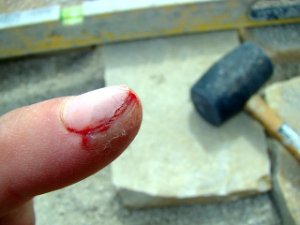
Tuft fractures are fractures of the cancellous bone at the distal tip. The integrity of the flexor and extensor tendons should be assessed with any injury to the distal phalanx. Nailbed injuries (that require repair) commonly accompany tuft fractures, as do subungual hematomas (that may need to be drained).
The middle phalanx is more susceptible to a direct blow to the dorsal side. The middle phalanx is injured with an axial force, parallel to the shaft.
A direct blow commonly causes proximal phalanx fractures but rotational forces and hyperextension can also cause injury. Proximal phalanx fractures are often angulated at the time of presentation (independent of mechanism) as muscle forces deform the unstable shaft. The collateral ligaments and volar plate at the metacarpophalangeal (MCP) joint stabilize the proximal portion and the extensor tendon pulls the distal fragment into extension.
objective evidence
Anteroposterior, lateral, and oblique images of each injured digit are needed. The lateral view should be taken so the other fingers do not obscure the injured digit. The oblique view can help diagnose fractures of the heads. Radiographs (Figure 3) should be examined for angulation, rotational alignment, and shortening; the presence of intra-articular extension should also be noted. Rotational deformities are usually diagnosed via physical examination rather than radiographic finding.
If an intra-articular fracture is suspected but not seen on plain radiograph, a CT scan can be useful.
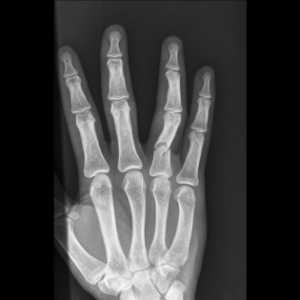
Once the fracture is reduced and splinted, post-splinting radiographs are taken. There should be no finger rotation, less than 2 mm of displacement or shortening, and less than 10 degrees of angulation.
Epidemiology
Phalangeal fractures are common. They are seen in athletic and work-related injuries. The precise incidence is not known, as many patients do not seek medical care.
Differential diagnosis
Collateral ligament tears are seen when there is forced ulnar/radial deviation, especially in the PIP joint, (i.e., “jamming” of the finger). Applying gentle varus and valgus force to the joint can test the ligaments.
Soft tissue trauma can cause swelling within the (confined) fibrous septae found in the pulp of the distal phalanx; blood can thereby accumulate.
Fractures are also seen with complex skin lacerations and nailbed injuries, such as subungual hematomas.
Flexor or extensor tendon injury may be seen with middle and distal phalangeal fractures. Mallet finger is an extensor tendon injury from a flexion blow to an extended DIP joint. It is seen as an inability to actively extend the DIP, leading to a flexion deformity of the DIP joint. Jersey finger is a flexor tendon injury (flexor digitorum profundus) from forceful extension of the flexed DIP joint. Injury typically occurs when the finger is caught on a jersey, usually while tackling, and most commonly affects the fourth digit.
Red flags
Loss of rotational anatomic alignment (Figure 4). Comminuted oblique, and spiral fractures are more likely to have loss of rotational alignment.
Soft tissue wounds with fracture suggest possible open fractures with soft tissue injury.
Dysfunction of flexion or extension of each phalanx. This can signal a middle phalanx base fracture, as the base of the middle phalanx is the insertion site of the flexor digitorum superficialis (FDS) tendon.
Loss of two-point discrimination (normal is 4-5 mm wide) or capillary refill (normal is less than 2 seconds).
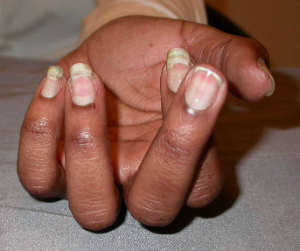
Treatment options and outcomes
The goal of treatment is to restore congruence of joint surfaces as well as anatomic alignment.
A majority of non-displaced fractures of the distal phalanx can be splinted with the DIP joint in extension for 3-4 weeks.
Most non-displaced proximal phalangeal fractures can be managed with a splint or even “buddy taping” (Figure 5).
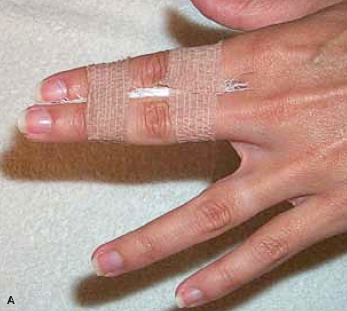
Active range of motion should be started after 3 weeks, with clinical healing (no pain with palpation or movement) taking 6-8 weeks to occur. Ice, elevation, and limitations of use can aid healing.
If the nail is separated from the nail root, it should be gently irrigated and then placed beneath the eponychium (cuticle) in order to assist in future nail growth.
Referral to a hand surgeon is needed with middle phalanx base fractures (as this is the insertion site of the flexor digitorum superficialis tendon), comminuted, rotational, intra-articular, oblique, and spiral fractures. Displaced or angulated fractures unable to be reduced adequately need prompt referral.
Surgical options include extension block splinting with Kirschner wires (Figure 6), closed reduction and internal fixation (CRIF) and open reduction and internal fixation (ORIF).
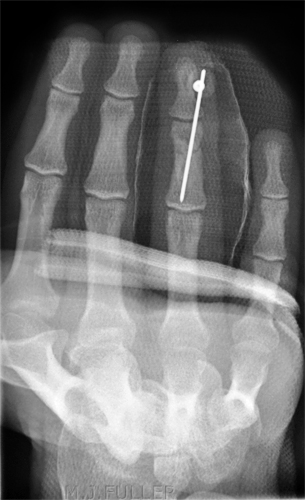
The outcome of phalanx fractures depends on many factors, including the forces causing the injury, patient compliance, type of treatment, length of immobilization, and medical expertise.
Stiffness is one of the most common complications following phalangeal fracture, correlating with the amount of soft tissue injury and age of the patient. Some degree of stiffness occurs in greater than 50% of proximal phalangeal fractures.
Nonunion (failure of the fracture to heal) is rare, and in the rare cases where this is seen, the lack of full healing is typically not clinically significant.
Malunion (healing with deformity) is common, especially with nonoperative treatment of fractures that should have been treated surgically. Osteotomy is performed to correct the deformity.
Post-traumatic arthritis is a potential complication of intra-articular fractures.
Risk factors and prevention
Individuals playing ball sports (basketball, football, baseball) are at a high risk for fractures as well as those with bone/joint disease (osteoporosis) and poor nutrition. Elderly patients are at a higher risk due to their increased likelihood of falls.
Miscellany
Wearing proper gloves and protective wear can decrease the chance of work-related phalangeal fractures.
The plural of phalanx is “phalanges” and the adjective is “phalangeal.” Etymology: The ancient Greek word “phalangos” means “line of battle,” referring to a tight array of 800 soldiers. The fingers, closely apposed, may be thought to resemble an infantry row – at least to the people who thought that the scaphoid looked like a boat, or that the coracoid process of the scapula resembled a raven’s beak.
Key terms
phalanges, phalangeal, fracture, distal, middle, proximal, tuft, nailbed, jersey, mallet, finger, proximal interphalangeal (PIP) joint, distal interphalangeal (DIP) joint, flexor digitorum profundus (FDP), flexor digitorum superficialis (FDS)
Skills
Accurately diagnose fractures on radiographs. Understand and demonstrate testing of FDS and FDP. Apply a radial or ulnar gutter splint. Describe and demonstrate testing for radial and ulnar digital neuropathies. Be able to describe a phalangeal fracture with correct terminology.
